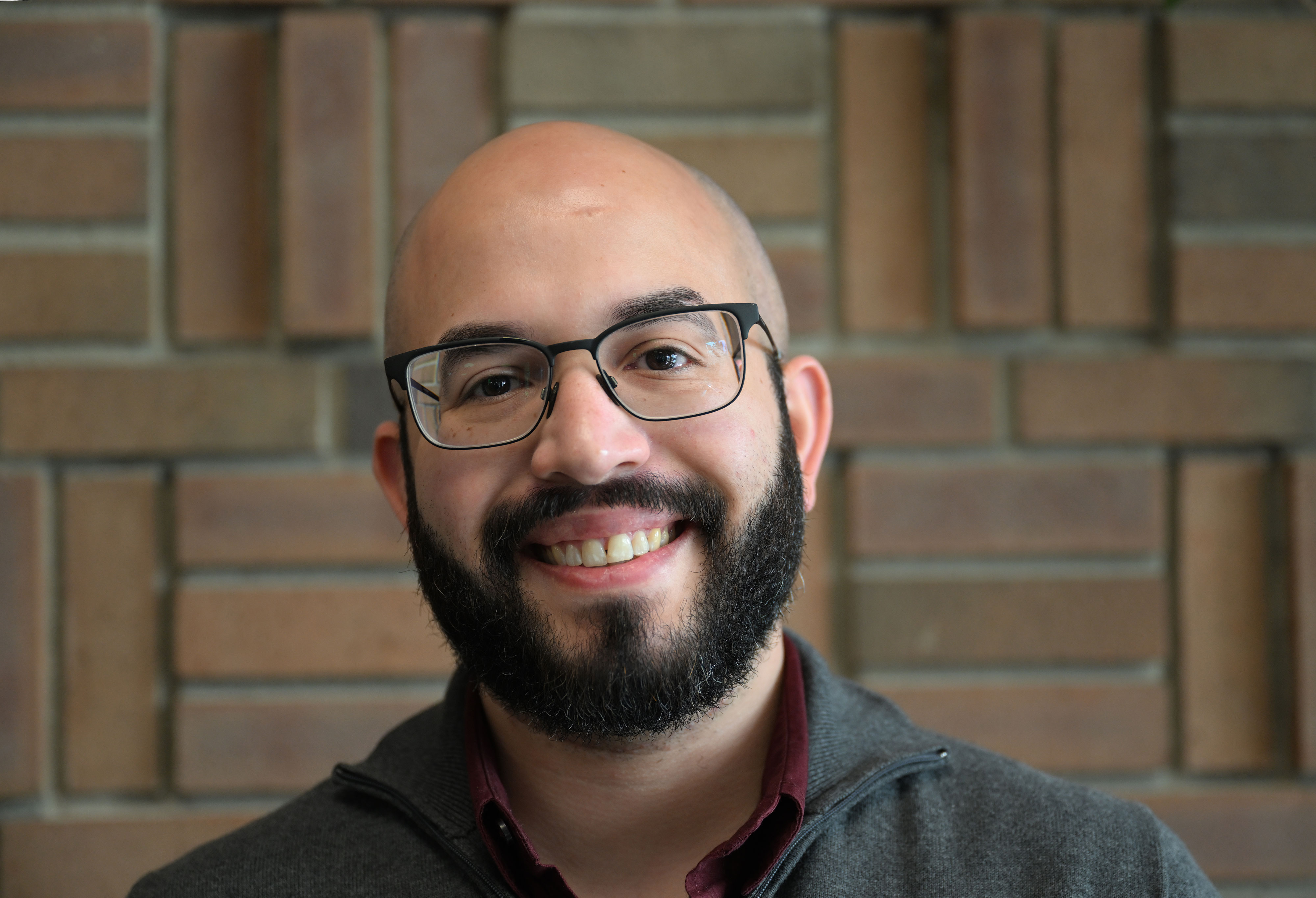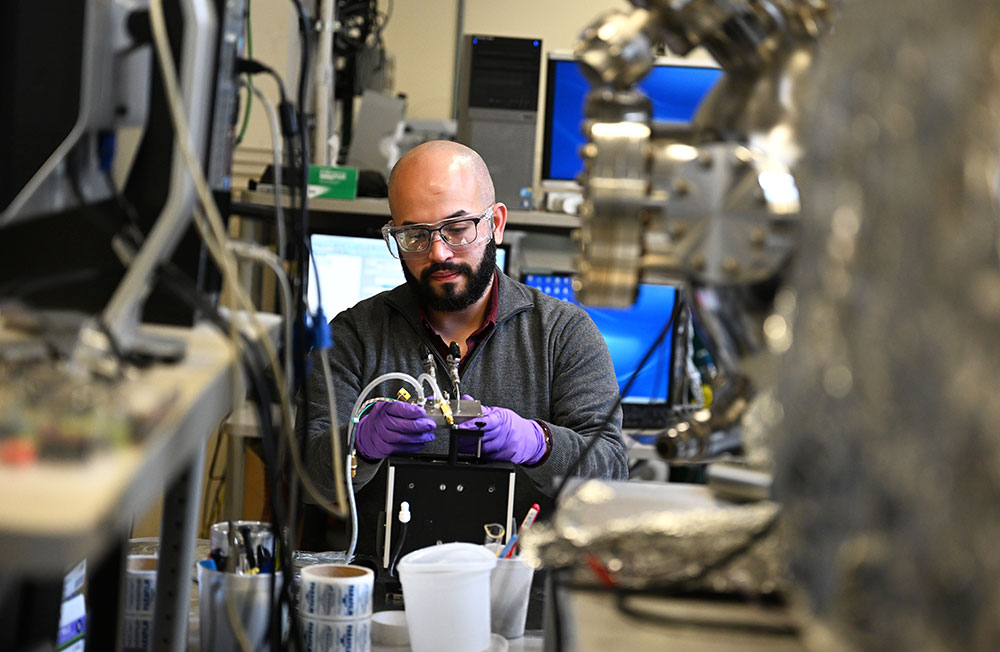Newswise — UPTON, N.Y. — The Blavatnik Family Foundation and the New York Academy of Sciences have recognized chemical engineer Juan Jimenez as a Finalist in the 2024 Blavatnik Regional Awards for Young Scientists. Jimenez’s catalysis science research at the U.S. Department of Energy’s (DOE) Brookhaven National Laboratory opens doors for turning climate change-driving gases into industrially useful materials.
The yearly honor is awarded to distinguished early career researchers at institutions in the New York Tri-State Area. Jimenez, a Goldhaber postdoctoral fellow in Brookhaven Lab’s Chemistry Division, was selected as a Chemical Sciences Finalist by a jury that considered 134 nominees. Only one Laureate and two Finalists were chosen for each of the three categories: chemical sciences, life sciences, and physical sciences and engineering. Jimenez will receive a medal along with $10,000 during the awards gala at the American Museum of Natural History in New York City on Tuesday, Oct. 1.
One of the grand challenges of our generation, climate change, “requires innovative and diverse solutions,” Jimenez reflected. “Being recognized as a Blavatnik Awards Finalist inspires me to elevate my field of clean energy, helping to make a brighter future for the next generation.”
He noted that his research falls firmly into the new DOE Energy Earthshots Initiative to reduce greenhouse gas emissions in a range of energy-intensive areas. “For 10 years now, I've been working on different parts of the same problem: converting carbon dioxide into some kind of useful product,” he said. The work contributes directly to DOE’s Clean Fuels and Products Shot, a subset of the broader Earthshots Initiative that aims to decarbonize the fuel and chemical industry.
Jimenez specializes in catalysts — in this case, they are clusters of atoms that expedite chemical reactions by lowering the energy required to get them started. He examined catalysts using X-ray techniques at the National Synchrotron Light Source II (NSLS-II) at Brookhaven and the Advanced Photon Source at DOE’s Argonne National Laboratory. These two DOE Office of Science user facilities produce intense beams of X-rays and other forms of light that researchers use to penetrate material samples and visualize atomic structures as well as materials’ electronic and chemical properties. Those studies, along with other experiments conducted by the Catalysis: Reactivity and Structure group in Brookhaven’s Chemistry Division, give Jimenez insight into his catalysts of interest and how they bring reactants together by helping break and rearrange chemical bonds.
Juan Jimenez at work in the lab. (Kevin Coughlin/Brookhaven National Laboratory)
One part of Jimenez’s research recognized by the award centered on methane dry reforming, in which a catalyst helps transform methane and carbon dioxide into synthesis gas (syngas), an ingredient for making valuable chemicals and fuels.
“The techniques at NSLS-II are critical in understanding a catalyst’s properties, such as the methane dry reforming catalyst’s structure, under operating conditions,” Jimenez noted. One technique, X-ray Absorption Spectroscopy, measures the energy absorbed by each element in the catalyst as a reaction is happening in real time. “This allows us to pinpoint precise changes in the atomic structure and chemical composition of the catalysts under real reaction conditions,” he explained. His seminal studies use data collected at the Inner-Shell Spectroscopy (ISS), Quick X-ray Absorption and Scattering (QAS), and In Situ Operando Soft X-ray Spectroscopy (IOS) beamlines.
“Currently, there are two ways to use methane at the level of large-scale industrial production,” explained Jimenez. “There’s steam reforming, which is the reaction of methane and water. That one is pretty much how we generate all the hydrogen in the world. But dry reforming, which transforms carbon dioxide and methane into syngas, is of interest because it has the novel approach of putting to use two greenhouse gases — even though it doesn't yield as much product as steam reforming right now.”
Jimenez’s work on developing new catalysts for dry reforming could change that.
An important aspect recognized by the award is that Jimenez’s research pushes the envelope on green chemistry's quest to minimize hazardous byproducts. Unlike many synthesis processes that require solvents, volatile substances that can be dangerous if inhaled, his reaction approach uses a solvent-free, or dry, process for making catalysts.
Jimenez is also being celebrated for his work on catalysts that convert carbon dioxide into ethylene, a precursor to making polyethylene and a hydrocarbon intermediate needed to manufacture jet fuel. His contributions might one day enable sustainable aviation by essentially recycling carbon dioxide.
Understanding catalysts at the molecular level helps scientists like Jimenez design them for a wide range of reactions and products. “In climate change initiatives, there's no such thing as a silver bullet. You need a whole host of different materials and different processes,” he said.
The chemistry bench isn’t the final frontier for Jimenez, though. He wants to move his discoveries into real-world applications, a process he described as a combination of basic science — like that conducted at NSLS-II — but also entrepreneurial and outreach efforts. At Brookhaven, he took a Lab-run course on entrepreneurship and filed a patent on technology to convert natural gas, where methane is a main component, into methanol, a liquid fuel. He also mentors students from minority-serving institutions on science and entrepreneurship to help them become inventors, too.
The Blavatnik Award recognizes the importance of these outreach efforts and Jimenez’s other contributions to diversity, equity, inclusion, and accessibility. As an adjunct professor at City College of the City University of New York (CUNY-CCNY), a leading Hispanic-Serving Institution, he taught a class on reaction engineering and kinetics. He recalled that this was one of the classes that inspired him to go into the field of catalysis when he was an undergraduate student. “To go back and not only teach the class that inspired me, but also teach it to students who reflect my same upbringing and background in my alma mater was a very full circle moment,” he said.
Yet Jimenez recognizes the importance of bringing all perspectives into the field. “Because we need a global solution for climate change, we need a global team,” he emphasized. Jimenez has collaborated with cross-cultural professional partners, from South America to Japan: “You learn how different global regions view the problem” — and work together on solutions.
Jimenez earned his Bachelor of Engineering in chemical engineering at CUNY-CCNY in 2015 and his Ph.D. from the University of South Carolina, also in chemical engineering, in 2020. He joined Brookhaven in 2020 as a research associate in the Chemistry Division. In 2021, he won the Goldhaber Distinguished Fellowship, and one year later, he served as the adjunct assistant professor of chemical engineering at CUNY-CCNY. His research has been featured on the front cover of the journals ACS Catalysis and the Journal of the American Chemical Society.
Jimenez’s research is funded by the DOE Office of Science.
Brookhaven National Laboratory is supported by the Office of Science of the U.S. Department of Energy. The Office of Science is the single largest supporter of basic research in the physical sciences in the United States and is working to address some of the most pressing challenges of our time. For more information, visit science.energy.gov.
Follow @BrookhavenLab on social media. Find us on Instagram, LinkedIn, X, and Facebook.


